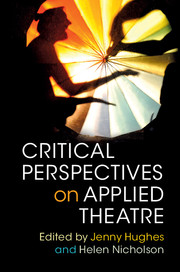Book contents
- Frontmatter
- Contents
- List of figures
- List of contributors
- 1 Applied theatre: ecology of practices
- PART I HISTORIES AND CULTURAL MEMORIES
- PART II PLACE, COMMUNITY AND ENVIRONMENT
- 6 Performing location: place and applied theatre
- 7 Peacebuilding performances in the aftermath of war: lessons from Bougainville
- 8 Applied theatre and climate change in Bangladesh: indigenous theatrics for neoliberal theatricks
- 9 Applied theatre and disaster capitalism: resisting and rebuilding in Christchurch
- PART III POETICS AND PARTICIPATION
- Notes
- Index
- References
9 - Applied theatre and disaster capitalism: resisting and rebuilding in Christchurch
from PART II - PLACE, COMMUNITY AND ENVIRONMENT
Published online by Cambridge University Press: 05 April 2016
- Frontmatter
- Contents
- List of figures
- List of contributors
- 1 Applied theatre: ecology of practices
- PART I HISTORIES AND CULTURAL MEMORIES
- PART II PLACE, COMMUNITY AND ENVIRONMENT
- 6 Performing location: place and applied theatre
- 7 Peacebuilding performances in the aftermath of war: lessons from Bougainville
- 8 Applied theatre and climate change in Bangladesh: indigenous theatrics for neoliberal theatricks
- 9 Applied theatre and disaster capitalism: resisting and rebuilding in Christchurch
- PART III POETICS AND PARTICIPATION
- Notes
- Index
- References
Summary
Some start with long slow rumbles reminiscent of an approaching underground train reaching a fever pitch deep in the earth below your feet. Others are short sharp jolts that disarm. Some are rolling and sliding quakes that turn the land under your feet to jelly. Others are performances of enormous intensity that seem to sharpen and clear the mind at the same time as they cloud and confuse any sense of safety. Still more are deadly, striking in the hearts of cities, causing grief and sorrow on a scale barely imaginable. Earthquakes perform in different ways. They are all spontaneous, unscripted improvisations of the world as it manipulates fault lines and tectonic plates, and although a major earthquake demands a repeat performance, the encore's timing cannot be guaranteed.
In Catania, Sicily, the earthquakes that rumble as a result of Etna's belligerence are managed through devotion to Saint Agata. Her golden image is paraded annually through the city in colourful pageants celebrating the times she has saved the city. Incan gods in Peru and Chile still ward off the evils that live under the South American mountains. In New Zealand, according to Maori understandings, the god Ruaumoko, still at the breast of Earth mother Papatuunuku, is kept warm by the fires in the centre of the world. The rumblings of volcanoes and earthquakes are made by Ruaumoko as he walks around. His wanderings frighten and pummel humans into spectators, into victimhood. They reduce, by their ferocity, any sense of agency, any possibility of resistance. Media representations of earthquakes enforce this sense of helplessness against uncompromising and relentless gods. Insurance companies routinely describe quakes as ‘acts of god’, implying that humans cannot be expected to be responsible for what has happened.
In September 2010, Ruaumoko stirred deep within the earth, and the Canterbury region of New Zealand was rocked by a magnitude 7.1 earthquake, which caused considerable physical damage but no deaths. Awakened again, on the 22nd of February 2011, a magnitude 6.3 earthquake killed 185 people in Canterbury's main city, Christchurch. No one realised at the time that this was the opening act of an ongoing communal and personal trauma that was to last for years. Ruaumoko was to prove restless and tireless, stirring time and time again.
- Type
- Chapter
- Information
- Critical Perspectives on Applied Theatre , pp. 172 - 190Publisher: Cambridge University PressPrint publication year: 2016
References
- 1
- Cited by



